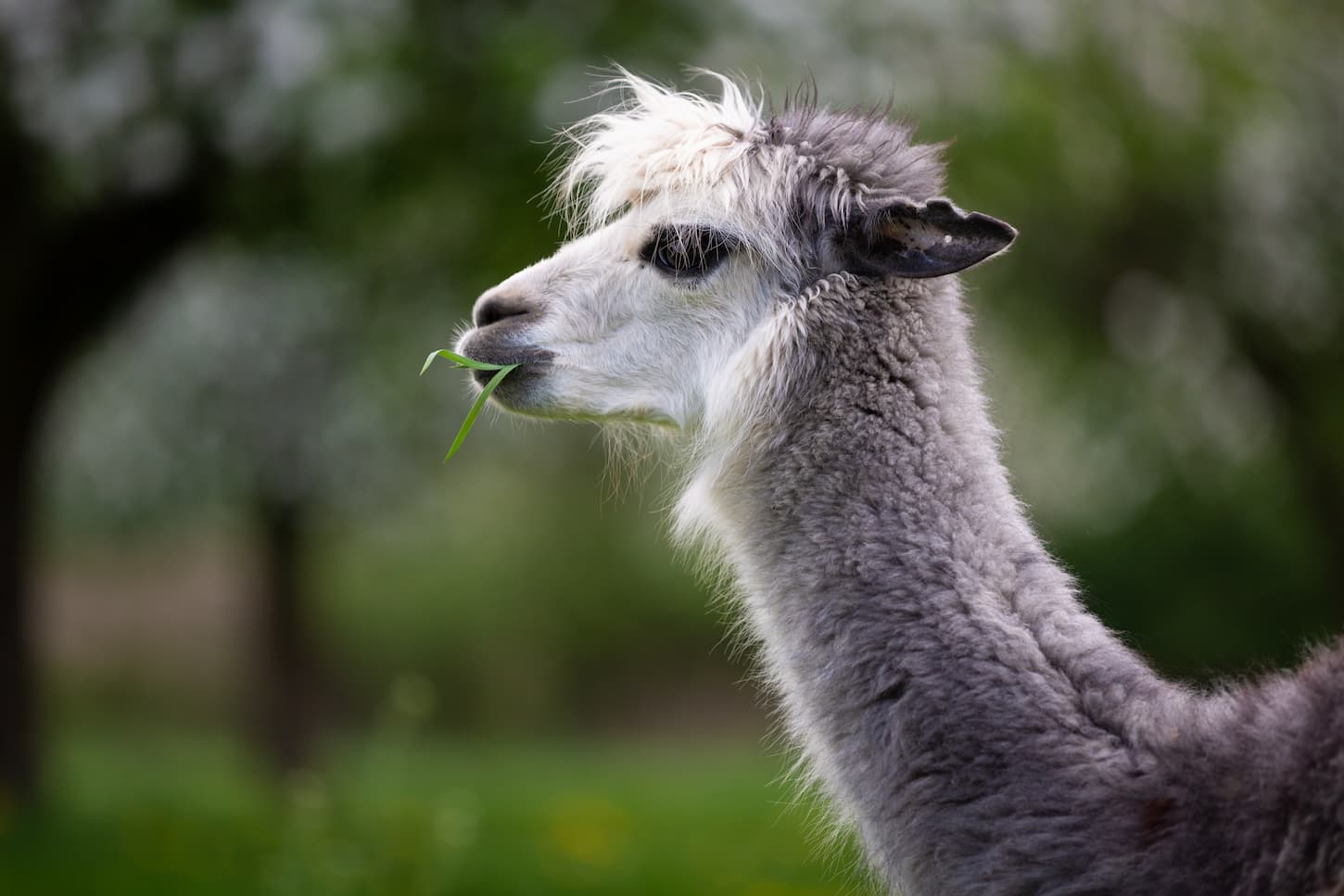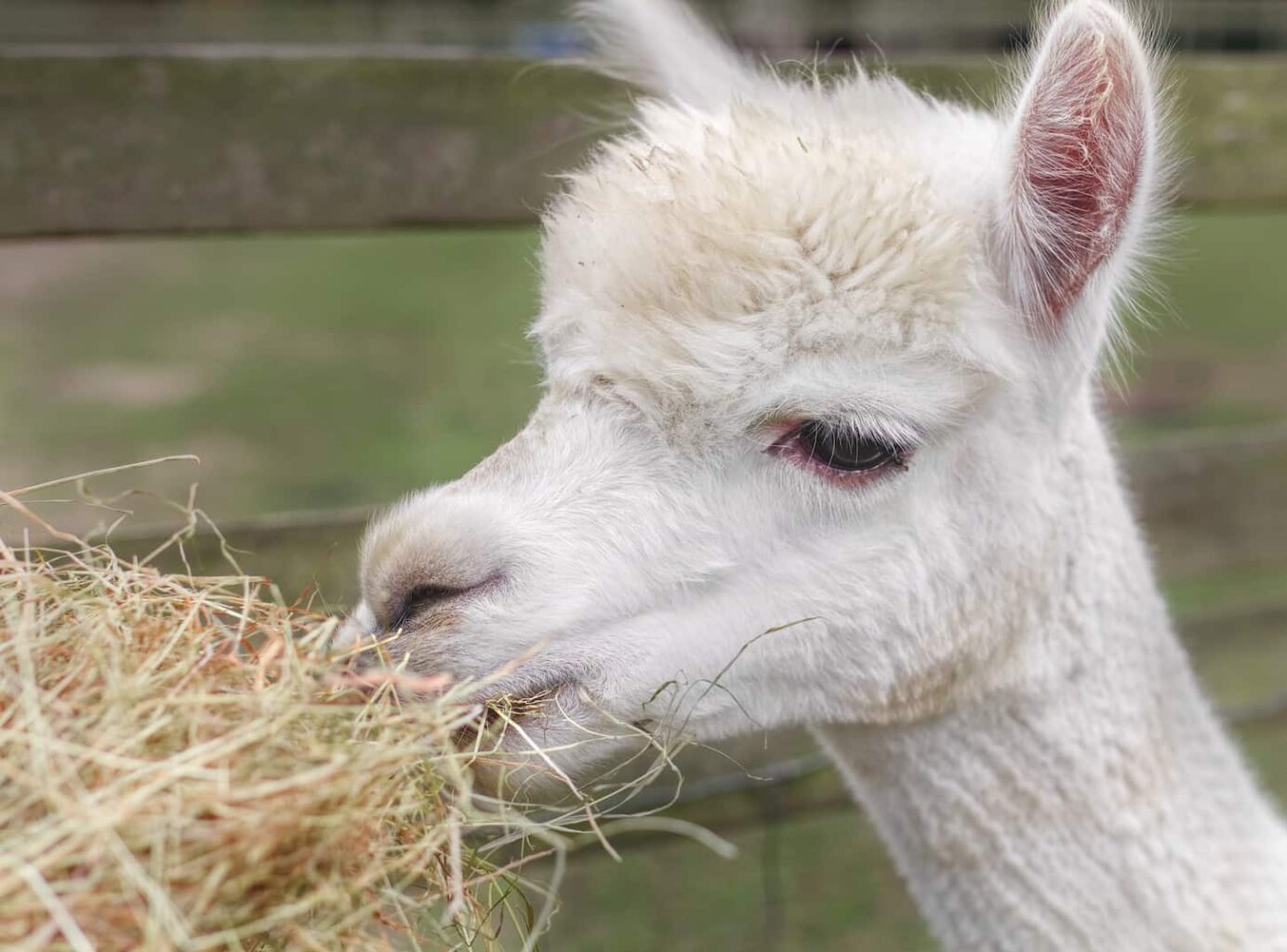Alpacas and llamas are becoming increasingly kept animals across the US, not least because of their friendly natures, cute appearances, and super soft wool! The two species have important similarities and differences that make them easy to tell apart. But what about on the inside? Are llamas and alpacas both ruminants?
Alpacas and llamas are modified ruminants, as they lack the fourth forestomach compartment of true ruminants. As part of the subspecies of camelids, they still regurgitate food, chew the cud, have an even number of toes, and are considered “pseudo ruminants” rather than “true” ruminants.
If you’re interested in alpacas and llamas, or even thinking about keeping a herd, you’ll need to find out about their physiology to understand what it’s like to keep them, and how and what llamas and alpacas eat. Here’s a friendly guide to the digestive system of these cute camelids, broken down into what you need to know and how it compares to your own digestive system!

The Digestive System of Alpacas and Llamas
Camelid digestion is by necessity more efficient and complex than a human’s digestive system. These animals have highly evolved systems that allow them to take all the nutrition that they need from less diverse diets, partly by having a more efficient system, but also by developing the ability to process food more than once!
Think about a camel in the desert, which needs to be able to get all of its nutrition from scarce plants. It can’t be picky and will need to get as much nutrition as it can from a very basic supply of food. The shared digestive biology between the camelid family is why alpacas and llamas, in particular, can not only survive but thrive so easily on simple diets and with comparatively less food than conventional livestock like cows and sheep (though more on this later).
Digestive Step #1: Chewing
The first thing that happens when food enters an alpaca or llama’s mouth is that they chew. Chewing has two functions: breaking food into smaller pieces and applying saliva. The saliva moistens the food but also contains some digestive enzymes which begin to break down food into chemical compounds that can be later used by the body to create energy.
Digestive Step #2: Digestion via stomach
For most of the different types of grazing animals found around the world, one stomach isn’t enough. Instead, they have multiple, which can help digest tough grassy foods. Many of the animals you’ll be familiar with from farms (such as sheep, cows, and goats) have four and are referred to as ruminants.
As both alpacas and llamas have three stomachs rather than four (a distinctive trait of the camelid family), they aren’t true ruminants but are instead known as “pseudo-ruminants.” Their three stomach rooms do however share many characteristics of those of true ruminants. In fact, camelid pseudo-ruminants get everything done that normal ruminants do. They just do it in three compartments instead of four.
Stomach #1: The Rumen (also known as C-1)
- This gives ruminants their name!
- This is a large compartment that stores food for 48 to 60 hours
- This ferments food with a potent mixture of bacteria, protozoa, and fungi
- This stomach also has muscular movements that keep the food stirred and mixed up!
- Here, the digestion process begins by fermenting, although there are no enzymes to break down food. It’s also where cud is regurgitated for further chewing!
Stomach #2: The Reticulum (known as C-2)
- Food comes here after its second chew
- Has a honeycomb-like structure
- This area works as a filter, separating anything bad the alpaca has eaten by mistake (perhaps the new earrings that you dropped in their pasture…) as well as returning large pieces of food for further chewing (again!)
Stomach #3: The Abomasum (also called C-3)
- Known as the ‘true stomach’, as it has a similar function to the human stomach
- Breaks down food and stomach acid for further digestion in the intestines by enzymes
True ruminants have an extra stomach known as the omasum before the abomasum which, similar in appearance to the page of a book, absorbs water and nutrients. While neither alpacas nor llamas have this as a separate stomach, the first part of the abomasum fulfills some of this function, which is why they are known as pseudo-ruminants.
Digestive Step #3: Intestinal absorption and excretion
After food passes through the stomach, the digestive system becomes much more comparable to ours. Food passes through the intestines, as much as possible is taken for nutrition and energy, and any leftover material is excreted as poop pellets.
A fun fact about both llamas and alpacas is that, unlike other farm animals, they like to leave their poop nice and tidy by forming dung piles, and will only go about their business in these places!
These natural toilet manners have meant that some people (who allow their herd indoors as pets) even train their animals not to go to the toilet inside their houses. But if you want to read about keeping alpacas indoors, I’ve got a whole article about how to do that – complete with examples.

Do llamas and Alpacas Chew Cud?
Yes, alpacas chew their cud! This means that alpacas often regurgitate food from their first stomach to be re-chewed. Just like alpacas, llamas also regurgitate their food to be chewed more. They will generally re-chew their food anywhere from 55-75 times before it’s swallowed again.
To understand what this process means more fully, let’s first consider what goes on inside these animals’ mouths. Both alpacas and llamas have split lips and long tongues that allow them to grab foliage easily and shove it in their mouths!
Once it’s in there, they have six incisors (sharp-cutting teeth), as well as molars for mashing their food. Later in life (around four years old), they develop canines too, but unlike humans, these aren’t for eating meat but instead for fighting with other animals. The top of their mouth is a hard roof with no teeth, as camelid chewing is more like a mortar and pestle than our chewing, which is like a knife!
As a side note, a significant difference between alpacas and llamas is that alpaca teeth don’t have the hard enamel casing that llamas’ do, which prevents the llamas’ teeth from growing. If you own alpacas, you may need to trim their teeth from time to time. If you do have your own and are thinking about this, consult a veterinarian who will be able to advise on whether this procedure is necessary.
If you want to read more about grooming alpacas and llamas, I’ve got complete guides for both. You can access the llama grooming article here and/or you can access the alpaca grooming article here. There are some similarities, but enough differences that you really should check out them both.
The camelid mouth structure is not suited to completely break down food in the mouth, so they generally chew quickly, with the purpose not to begin the digestive process but just to mix enough saliva into their food for it to slide down their throats easily.
After their food has gone down, you might be able to see a lump of food passing back up your animals’ throats — this is what that famous ‘chewing the cud’ is all about! The food passes from their first stomach (yes the first. Be sure to refer back to the section on camelid digestive systems earlier in this article for more details) and they continue chewing in their distinctive figure-of-eight chewing motion.
But why do alpacas and llamas need to chew cud? To understand more about why they (and other grazing animals) do this, we’ll need to travel further down through the tunnels of the alpaca’s digestive system. Because it’s due to what they eat.
What Do Llamas and Alpacas Eat?
Healthy llamas and alpacas generally eat a variety of grasses, foliage, and plant matter of around 2% of their body weight a day. That’s actually a very similar rate to most people and relatively less than some grazing animals. Active or pregnant animals can eat as much as double the standard 2% of their bodyweight rule of thumb.
If you’re thinking about getting a herd of your own, bear in mind that while the percentage is the same, llamas are much larger animals than alpacas. In fact, at almost double the size on average, llamas will require a lot more food.
Llamas and alpacas are herbivores, so they only eat plants. They rely mostly on a grass-based diet, but will happily eat other foliage. The alpaca’s digestive system of course allows it to process this food much more thoroughly than a human could, which is why they can get so much nutrition out of things that are inedible to us.
However, did you know that even compared to other grazing animals their digestive systems are impressive, and they can eat up to 25% more diversely than a sheep could? I was shocked to learn that in my own research, but it’s a kind of cool fact that’s stuck with me.
It’s generally recommended that alpacas eat mostly grass or grass hay, but they can also be fed alfalfa hay in certain circumstances such as growing or pregnancy. However, feeding too much alfalfa hay can also cause significant health problems.
You can also provide commercially produced llama and alpaca feeds, which normally come in the form of pellets. Just remember that it’s important to offer these according to the correct amounts suggested by the brand, otherwise the animals can quickly become obese.
If you choose a commercial feed, you will also need to provide salt licks, which should be copper-free as camelids have a low tolerance to copper in their diets (just like sheep, who share this dietary need). Sweet feeds, which are high in carbohydrates such as sugars, can also cause significant problems to camelid stomachs.
When changing diets, do so slowly, over the course of up to two weeks. The bacterial climate of the C1 stomach is specific to feeding types, so by changing too quickly you can upset these delicate balances and inadvertently cause health issues. If you have or are considering getting alpacas or llamas, but you’re unsure what to feed them, first consult a professional such as a veterinarian or animal nutritionist to get the best advice.
Final Thoughts on Pseudo-Ruminants (Alpacas & Llamas)
Llamas and alpacas are amazing animals. Camelids (and other ruminants, be they true or modified) have evolved to do amazing things while living on a limited, plant-based diet. Plus, they’re just stinking cute.
But by knowing more about their digestive physiology, you’ll be better able to understand why an overnight diet change is such a horrible idea – it’ll throw their rumen’s floral microbiology into a ruckus. And then you get an animal who’s sick with bloat and/or diarrhea.
So make sure you understand why this is – so that you can slow food transitions down. That way, the rumen flora are happy and so are the llamas and alpacas.
Resources
Learning from your own experience is essential, but learning from others is also intelligent. These are the sources used in this article and our research to be more informed as homesteaders.
- ANIMAL CARE AND WELL-BEING FREQUENTLY ASKED QUESTIONS: LLAMA & ALPACA. Michigan State University Extension 4-H Program, www.canr.msu.edu/uploads/236/67842/llama_bookmarks_web_3up-6-21-16-AA.pdf.
- Esteban, L. R., and J. R. Thompson. The Digestive System of New World Camelids – Common Digestive Diseases of Llamas. Iowa State University, lib.dr.iastate.edu/cgi/viewcontent.cgi?article=3280&context=iowastate_veterinarian.
